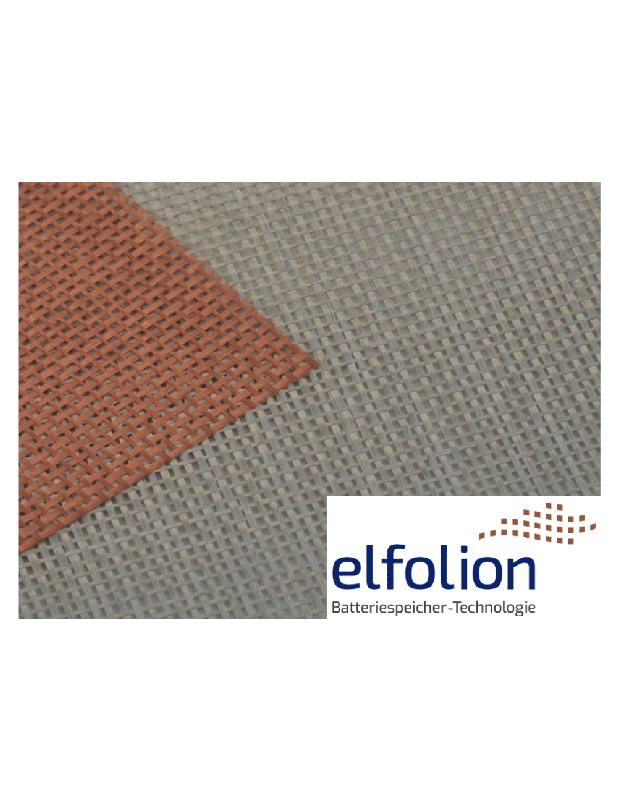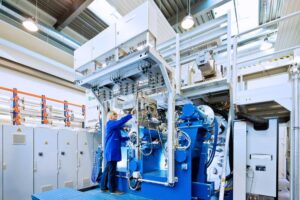High-efficiency electrodes with ultralight fabric-based current collectors for lithium-ion batteries

Basic design of the fabric-based electricity collector in aluminum and copper
© elfolion GmbH
Lithium-ion batteries (LIB) are indispensable key components for electro mobility and the success of the energy transition. They offer high energy density and high cycle stability. Eight partners from industry and science are developing technologies and components in the funded project “revoLect” (funding reference: 03ETE041) in order to be able to produce resource-saving and more efficient LIBs. The project is pursuing two key innovations: the replacement of the usual metal foils with a metallized fabric structure and the use of silicon asanode material.
Batteries are one of the key components for the success of the global energy transition. They are indispensable as stationary energy storage devices in combination with electricity from renewable energies and are a basic prerequisite for electro mobility. The demand for batteries is currently increasing enormously. Already, about 16% of newly registered passenger cars in Germany have an electric drive1. In addition to this increasing demand for electro mobility, there is also an increasing demand for batteries for smartphones, laptops, electric bicycles and stationary energy storage.

Credit: Jügen Lösel / © Fraunhofer FEP
The most important current battery type is lithium-ion batteries (LIB). Their high energy density and high cycle stability offer a long range for electric vehicles at marketable costs. The task now is to exploit the potential of the batteries by further developing all their components and their production technologies. This is the goal pursued by the eight project partners of the revoLect project funded by the German Federal Ministry for Economic Affairs and Climate Action. The project partners are pooling their expertise along the entire process chain of battery production. In the project, novel electrodes with lightweight fabric-based current collectors are being developed for lithium-ion batteries using a resource-saving technology. This technology requires less use of primary raw materials such as copper and aluminum compared to previous lithium-ion batteries. At the same time, this technology enables higher energy densities and thus further material savings from the cell to the system level. Another development focus is the use of pure silicon as anode material in combination with the lightweight fabric structure of the electrodes.
Project partner PORCHER INDUSTRIES GERMANY GmbH is a specialist in the production of glass fabrics from glass filament yarns. In the revoLect project, PORCHER INDUSTRIES is developing ultralight glass fabrics as the basis for electricity collectors. The aim here is to produce ultralight fabrics from the finest glass filament yarns. In parallel, the Dresden University of Technology, Institute of Textile Machinery and High Performance Material Technology (ITM), is developing ultralight carbon fabrics based on a carbon spreading technology for the highly efficient electrodes.
The developed carbon and glass fabrics are metallized by elfolion GmbH by vacuum processes for use as current collectors. The current collector strip material is provided for the production of composite electrodes. elfolion itself is aiming at the realization of a cell cathode, consisting of fractal porous solid structures, which are the active component of the electrode. Compared to the state of the art, the open-mesh and lightweight structure of the fabrics and the porous coating lead to significantly reduced material usage and larger active surfaces. This increases the energy density of battery cells significantly in terms of both mass and volume.
The RWTH Aachen University, Chair of Production Engineering of E-Mobility Components (PEM), is developing processes for coating the fabric-based current collectors with slurry-based electrode materials. Among other things, the pilot plant for cell production is being adapted to process the novel materials. In addition, it is investigating the design and production of the battery cells based on the components provided by the project partners.
Fraunhofer FEP’s goal in the revoLect project is to develop a process for depositing silicon on the fabric structures. Claus Luber explains: “We have to match the silicon layer and the fabric structures in such a way that an optimum is achieved with regard to the gravimetric energy density of the anode. Fraunhofer FEP has decades of experience in the development of roll-to-roll technologies. Based on this, we will develop a suitable and economically attractive roll-to-roll vapor deposition process.”
The partner CUSTOMCELLS® coats the novel substrates with electrode paste under industry-standard conditions. Subsequently, the performance of the batteries is tested by electrochemical measurements.
The Institute for Experimental Physics at the Technical University of Freiberg is involved in the characterization of the processed individual components and button and pouch cells. From this, microstructure-property correlations as well as design proposals and processing parameters will be derived for the cooperation partners.
ROMONTA GmbH interconnects the manufactured cells to battery systems and carries out final practice-related application tests. In the evaluation, cell parameters such as aging and current/voltage resistance are to be analyzed and transferred to the mobile application. This will ensure the powerful performance of the LIB.
Lithium-ion batteries with significantly increased energy density and lower material consumption compared to the state of the art: this is the ambition of the project consortium. All partners in the revoLect project will be working at full speed over the next 3 years on application-oriented development along the entire process chain for the production of highly efficient lithium-ion batteries.
1 source: ADAC new car registrations in November 2022, www.adac.de/news/neuzulassungen-kba
About the project:
revoLect – High-efficiency electrodes with ultralight fabric-based current collectors for lithium-ion batteries. Subproject: Development of vacuum technologies for the productive deposition of columnar silicon layers on fabric.
Funding reference: 03ETE041
Duration: 01.09.2022 – 31.08.2025
Project partners:
– Fraunhofer Institute for Organic Electronics, Electron Beam and Plasma Technology FEP
– Technical University of Freiberg – Faculty of Chemistry and Physics – Institute for Experimental Physics
– Rheinisch-Westfälische Technische Hochschule Aachen – Faculty 4 – Mechanical Engineering – Chair of Production Engineering of E-Mobility Components (PEM)
– Dresden University of Technology – Faculty of Mechanical Engineering – Institute for Textile Machinery and Textile High Performance Materials
– Porcher Industries Germany GmbH
– elfolion GmbH
– ROMONTA GmbH
– CUSTOMCELLS®
Press contact:
Ms. Annett Arnold
Fraunhofer Institute for Organic Electronics, Electron Beam and Plasma Technology FEP
Phone +49 351 2586 333 | presse@fep.fraunhofer.de
Winterbergstraße 28 | 01277 Dresden | Germany | www.fep.fraunhofer.de
Weitere Informationen:
Media Contact
All latest news from the category: Power and Electrical Engineering
This topic covers issues related to energy generation, conversion, transportation and consumption and how the industry is addressing the challenge of energy efficiency in general.
innovations-report provides in-depth and informative reports and articles on subjects ranging from wind energy, fuel cell technology, solar energy, geothermal energy, petroleum, gas, nuclear engineering, alternative energy and energy efficiency to fusion, hydrogen and superconductor technologies.
Newest articles

Largest magnetic anisotropy of a molecule measured at BESSY II
At the Berlin synchrotron radiation source BESSY II, the largest magnetic anisotropy of a single molecule ever measured experimentally has been determined. The larger this anisotropy is, the better a…

Breaking boundaries: Researchers isolate quantum coherence in classical light systems
LSU quantum researchers uncover hidden quantum behaviors within classical light, which could make quantum technologies robust. Understanding the boundary between classical and quantum physics has long been a central question…

MRI-first strategy for prostate cancer detection proves to be safe
Active monitoring is a sufficiently safe option when prostate MRI findings are negative. There are several strategies for the early detection of prostate cancer. The first step is often a…



